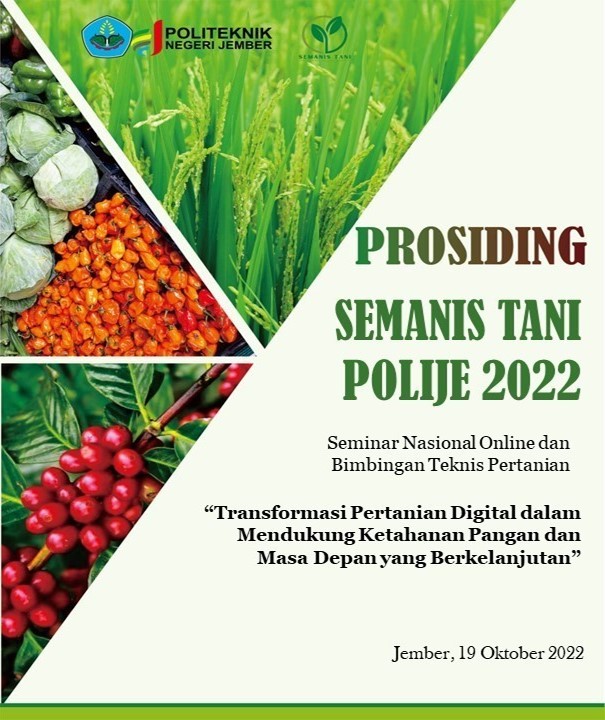Potensi Asap Cair Arang Sekam terhadap Spodoptera litura dan Pengaruhnya terhadap Keanekaragaman Artropoda pada Tanaman Kedelai Edamame
DOI:
https://doi.org/10.25047/agropross.2022.303Kata Kunci:
Edamame soybeans, liquid smoke of husk charcoal, S. litura, toxicityAbstrak
This study aimed to examine the potential of husk charcoal liquid smoke as a bioinsecticide in controlling S. litura and its effect on the diversity of arthropods in Edamame soybeans. The research was conducted from February 2021 to June 2021, at The Plant Protection Laboratory, Bioscience Laboratory Jember State Polytechnic and farmers' land in Balung Lor Village, Jember Regency. Laboratory research examines the bioactive components of 3rd grade husk charcoal liquid smoke, toxicity. The treatment of liquid smoke of husk charcoal, compared with Fipronil as a positive control, used the Mann Whitney test. Observations were: S. litura population, damage intensity, pod weight per plant and arthropod diversity. The results of the the research were: GCMS analysis showed that the liquid smoke of husk charcoal 3rd grade contains 35 components that were detected by a mass spectrometer. The bioactive compound as an antifeedant with the highest concentration was Acetic Acid, ws 37.03%. LC50 and LC95 were 9% and 28% respectively; The liquid smoke of husk charcoal was more effective in reducing the population of S. litura and the damage intensity; pods weight 48.92 grams per plant, Fipronil 23.92 grams per plant. Shannon Wiener Diversity Index of husk charcoal liquid smoke was 2.57 Fipronil was 1.85, Sorensen similarity index was 77% (different). The dominance index of Simpson bioinsecticide liquid smoke husk charcoal was 0.10 lower than Fipronil, which was 0.54.
Unduhan
Referensi
As’ad, M.F., Kaidi, Syarief, M. (2018). Resistency Status of Leptocorisa acuta on Synthetic Insecticides and Its Susceptibility on Beauveria bassiana on Rice. Agriprima, Journal of Applied Agricultural Sciences. 2(1): 86-94
DOI: 10.25047/agriprima.v2i1.80
Dewi, F.C., Tuhuteru, S, Aladin, A. dan Yani, S. (2021). Kajian Pemanfaatan Biopestisida Asap Cair Limbah Biji Buah Merah terhadap Mortalitas Ulat Grayak (Spodoptera litura F). “Membangun Sinergi antar Perguruan Tinggi dan Industri Pertanian dalam Rangka Implementasi Merdeka Belajar Kampus Merdeka”5(1):083-1091). Surakarta, Universitas Sebelas Maret.
Retieved from.https://jurnal.fp.uns.ac.id/index.php/semnas/article/view/1846
Bayo, F.S., (2021). Indirect Effect of Pesticides on Insects and Other Arthropods. NCBC (The National Center for Biotechnology Information). 9(8): 177.
DOI: 10.3390/toxics9080177
Abbot, W.S. (1987) A method of computing the effectiveness of an insecticide. Journal of The American Moscuito Control Association. 3(2): 302-303 Retieved from.
https://www.biodiversitylibrary.org/content/part/JAMCA/JAMCA_V03_N2_P302-303.pdf
Guedes, RNC, Smagghe, G., Stark, JD & Desneux, N.. (2016). Pesticide Induced Stress in Arthropod Pests for Estimized Integrated Pest Management Programs. Annual Reviewers. 6(1): 43-62 p. Retieved from
DOI: 10.1146/annurev-ento-010715-023646
Haji, A.G., Mas’ud, Z.A. dan Gustan Pari, G. 2012. Identifikasi Senyawa Bioaktif Antifeedant dari Asap Cair Hasil Pirolisis Sampah Organik Perkotaan. Jurnal Bumi Lestari, 12(1):1 – 8.
Retieved from https://ojs.unud.ac.id/index.php/blje/article/view/1528
Isa, I., Musa, W.J.A., 2 , Rahman, S.W. 2019. Pemanfaatan Asap Cair Tempurung Kelapa Sebagai Pestisida Organik Terhadap Mortalitas Ulat Grayak (Spodoptera Litura F.). Jambura Journal of Chemistry.01 (1):15-20 Retieved from
DOI: https://doi.org/10.34312/jambchem.v1i1.2102
Istiqomah dan Kusumawati, D.E., 2019. Potensi Asap Cair dari Sekam untuk Meningkatkan Pertumbuhan dan Produksi Padi (Oryza sativa L.). Buana Sains 19(2): 23 – 30.
DOI: https://doi.org/10.33366/bs.v19i2.1745
Kalshoven LGE. (1981). The Pests of Crops in Indonesia. Jakarta: Ichtiar Baru.
Krebs, C. J. (2017). Chapter 13. Species diversity measures. In Ecological methodology (pp. 531- 595). Retieved from
https://www.zoology.ubc.ca/~krebs/downloads/krebs_chapter_13_2017.pdf
Marwoto. 2006. Status Hama Pengisap Polong Kedelai Riptortus linearis dan Cara Cengendaliannya. Bul. Palawija 12: 69–74. Retieved from
https://balitkabi.litbang.pertanian.go.id/wp-content/uploads/2017/02/bp_no-12_2006_04.pdf
McAlpine JF. (1987). Manual of Nearctic Diptera Volume 2. Ottawa: Research Branch Agriculture Canada.
Odum, E.P. 1993. Dasar dasar Ekologi. Samingan,T., Srigandono, B. Yogyakarta, Gadjah Retieved from Mada University Press. https://lib.ui.ac.id/detail.jsp?id=137460
Prabaningrum, L.1., Uhan, T.S.1., Nurwahidah, U., Karmin dan Hendra, A.1., 2013. Resistensi Plutella xylostella terhadap Insektisida yang Umum Digunakan oleh Petani Kubis di Sulawesi Selatan. J. Hort. 23(2):164-173
Retieved from
http://portalgaruda.fti.unissula.ac.id/?ref=browse&mod=viewarticle&article=453630
Roma, G.C., deOliveira, P.R., Pizano, M.A., Izabel, M., & Mathiasa, C. (2009). Determination of LC50 of permethrin acaricide in semi-engorged females of the tick Rhipicephalus sanguineus (Latreille, 1806) (Acari: Ixodidae). Experimental Parasitology 123(3):269-272
DOI.org/10.1016/j.exppara.2009.08.001
Sari, W.P., Adriani, D.E., & Nisa, C. (2021). Respon pertumbuhan kedelai Edamame (Glycine max L. Merr.) dengan aplikasi pupuk hayati urea dan rhizobium pada media tanah gambut. Tropical Wet Land Journal. 7(1):1-46.
DOI https://doi.org/10.20527/twj.v7i1.100
Syarief, M., G. Mudjiono, A.L., Abadi, T. Himawan (2018). Arthropods diversity and population dynamic of Helopeltis antonii Sign. (Hemiptera: Miridae) on various cocoa agroecosystems management. Agrivita Journal of Agricultural Science 40 (2): 350-359.
DOI.org/10.17503/agrivita.v39i2.1038
Spiller, M.S. Spiller, C., & Garlet, J. (2018) Arthropod bioindicators of environmental quality. Artigo. 12(1): 41-57. Retieved from
DOI: https://doi.org/10.18227/1982-8470ragro.v12i1.4516
Wibowo, Y., Amilia, W., Karismasari, D.R., (2020) Manajemen risiko kehilangan panen Edamame (Glycine max (L) merr.) di PT. Mitratani dua tujuh, Jember. Jurnal Agroteknologi, 14(2): 165-178 Retieved from DOI: https://doi.org/10.19184/j-agt.v14i02.21448
Unduhan
Diterbitkan
Cara Mengutip
Terbitan
Bagian
Lisensi
Hak Cipta (c) 2022 Mochamad Syarief, Iqbal Erdiansyah

Artikel ini berlisensi Creative Commons Attribution 4.0 International License.
Hak cipta (Copyright) artikel yang dipublikasikan di Agropross : National Conference Proceedings of Agriculture dipegang oleh penulis (Copyright by Authors) di bawah Creative Commons Attribution 4.0 International License (CC-BY). Sehingga penulis tidak memerlukan perjanjian pengalihan hak cipta yang harus diserahkan kepada redaksi.






